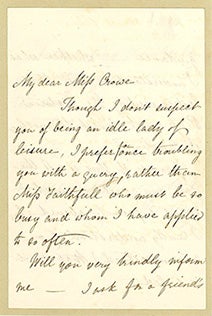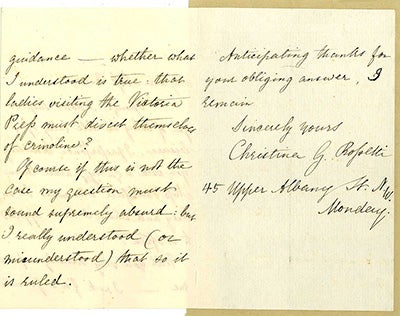Study of a primary source such as a letter or diary is not just about performing research. You are physically, intellectually and emotionally interacting with the past. What drew you to the item in the first place? Let curiosity be the guide in finding out more about both item and creator. Ask questions about them, and set out to find the answers if you can. In a way, a researcher is a combination of detective and journalist: the former identifies the physical evidence, the latter reveals context and develops a narrative or backstory about the item and creator, with the ultimate aim of showing the world why they are important.
 Here is a letter written by Christina Rossetti to a Miss Crowe regarding a forthcoming visit to the Victoria Press, which was founded by Emily Faithfull in England in 1860. Questions that could be asked to reveal context and develop a narrative about this item might include:
Here is a letter written by Christina Rossetti to a Miss Crowe regarding a forthcoming visit to the Victoria Press, which was founded by Emily Faithfull in England in 1860. Questions that could be asked to reveal context and develop a narrative about this item might include:
—Can you read the letter? (Cheat: see transcription below)
—Who was Christina Rossetti?
—What is crinoline? Why was its removal required during visits to such places as the Victoria Press?
—What was the Victoria Press?
—Who was Emily Faithfull and what was her significance in the 19th-century publishing industry?
—Look for contextual markers such as writing style, punctuation, penmanship; references to dress.
—Consider looking at related subjects to establish the significance of the item in a broader historical and cultural context: women’s rights, business women, publishing industry, British history, 1815-1914, Victorian period literature.
Letter transcription:
My dear Miss Crowe
Though I don’t suspect you of being an idle lady of leisure, I prefer for once troubling you with a query, rather than Miss Faithfull who must be so busy and whom I have applied to so often.
Will you very kindly inform me – I ask for a friend’s guidance – whether what I understood is true: that ladies visiting the Victoria Press must divest themselves of crinoline?
Of course if this is not the case my question must sound supremely absurd: but I really understood (or misunderstood) that so it is ruled. Anticipating thanks for your obliging answer. I remain
Sincerely yours
Christina R. Rossetti
45 Upper Albany Street, N.W.
Monday
Find help on researching primary sources in the Special Collections guide on Archival Research. Read more about researching primary sources in the “Making Sense of Evidence” series at HistoryMatters.GMU.edu Look out for more of my blog posts on working with manuscripts as primary sources.
Lisette Matano, Manuscripts Archivist
September 22, 2016

